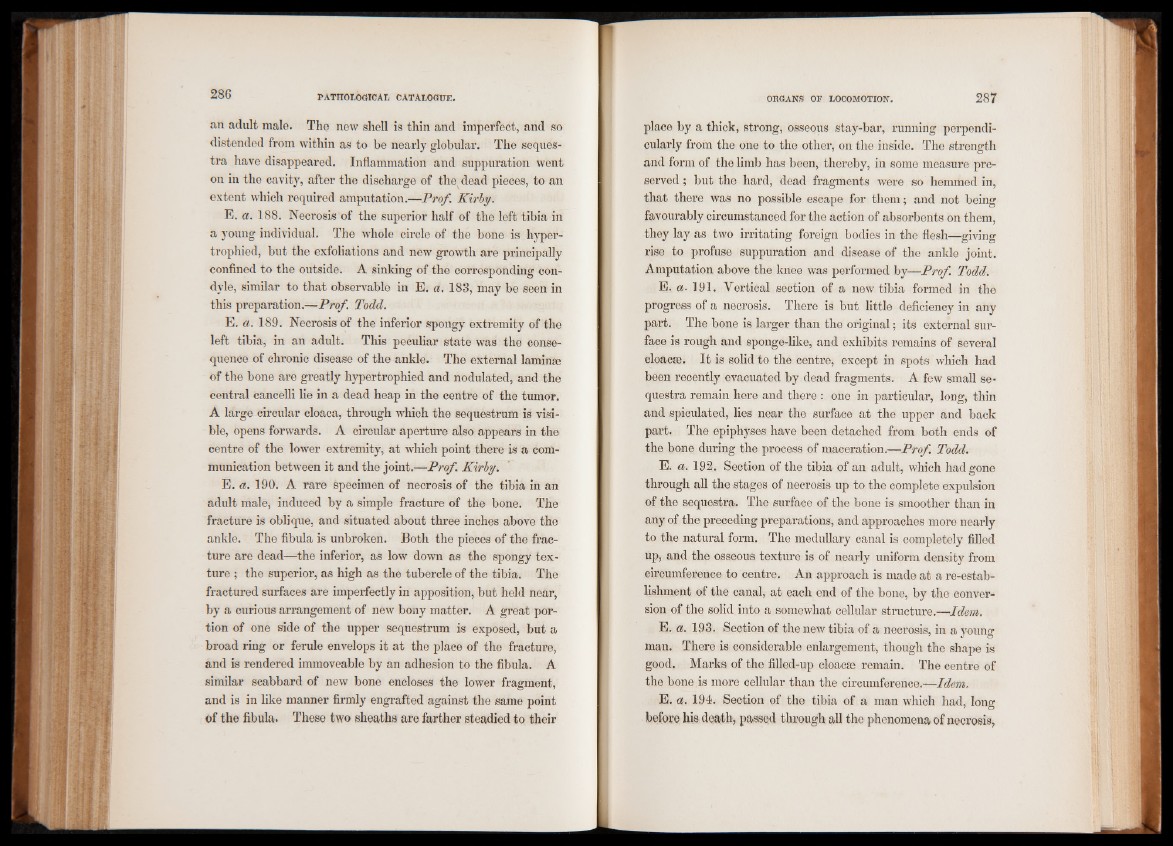
an adult male. The new shell is thin and imperfect, and so
distended from within as to be nearly globular. The sequestra
have disappeared. Inflammation and suppuration went
on in the cavity, after the discharge of the dead pieces, to an
extent which required amputation.—Prof. Kirby.
E. a. 188. Necrosis of the superior half of the left tibia in
a young individual. The whole circle of the bone is hypertrophied,
but the exfoliations and new growth are principally
confined to the outside. A sinking of the corresponding condyle,
similar to that observable in E. a. 183, may be seen in
this preparation.—Prof. Todd.
E. a. 189. Necrosis of the inferior spongy extremity of the
left tibia, in an adult. This peculiar state was the consequence
of chronic disease of the ankle. The external laminae
of the bone are greatly hypertrophied and nodulated, and the
central eancelli lie in a dead heap in the centre of the tumor.
A large circular cloaca, through which the sequestrum is visible,
opens forwards. A circular aperture also appears in the
centre of the lower extremity, at which point there is a communication
between it and the joint.—Prof. Kirby.
E. a. 190. A rare specimen of necrosis of the tibia in an
adult male, induced by a simple fracture of the bone. The
fracture is oblique, and situated about three inches above the
ankle. The fibula is unbroken. Both the pieces of the fracture
are dead—the inferior, as low down as the spongy texture
; the superior, as high as the tubercle of the tibia. The
fractured surfaces are imperfectly in apposition, but held near,
by a curious arrangement of new bony matter. A great portion
of one side of the upper sequestrum is exposed, but a
broad ring or ferule envelops it at the place of the fracture,
and is rendered immoveable by an adhesion to the fibula. A
similar scabbard of new bone encloses the lower fragment,
and is in like manner firmly engrafted against the same point
of the fibula. These two sheaths are farther steadied to their
place by a thick, strong, osseous stay-bar, running perpendicularly
from the one to the other, on the inside. The strength
and form of the limb has been, thereby, in some measure preserved
; but the hard, dead fragments were so hemmed in,
that there was no possible escape for them; and not being
favourably circumstanced for the action of absorbents on them,
they lay as two irritating foreign bodies in the flesh—giving
rise to profuse suppuration and disease of the ankle joint.
Amputation above the knee was performed by—Prof. Todd.
E. a- 191. Vertical section of a new tibia formed in the
progress of a necrosis. There is but little deficiency in any
part. The bone is larger than the original; its external surface
is rough and sponge-like, and exhibits remains of several
cloacae. It is solid to the centre, except in spots which had
been recently evacuated by dead fragments. A few small sequestra
remain here and there : one in particular, long, thin
and spiculated, lies near the surface at the upper and back
part. The epiphyses have been detached from both ends of
the bone during the process of maceration.—Prof. Todd.
E. a. 192. Section of the tibia of an adult, which had gone
through all the stages of necrosis up to the complete expulsion
of the sequestra. The surface of the bone is smoother than in
any of the preceding preparations, and approaches more nearly
to the natural form. The medullary canal is completely filled
up, and the osseous texture is of nearly uniform density from
circumference to centre. An approach is made at a re-establishment
of the canal, at each end of the bone, by the conversion
of the solid into a somewhat cellular structure.—Idem.
E. u. 193. Section of the new tibia of a necrosis, in a young
man. There is considerable enlargement, though the shape is
good. Marks of the filled-up cloacae remain. The centre of
the bone is more cellular than the circumference.—Idem.
E. a. 194. Section of the tibia of a man which had, long
before his death, passed through all the phenomena of necrosis,